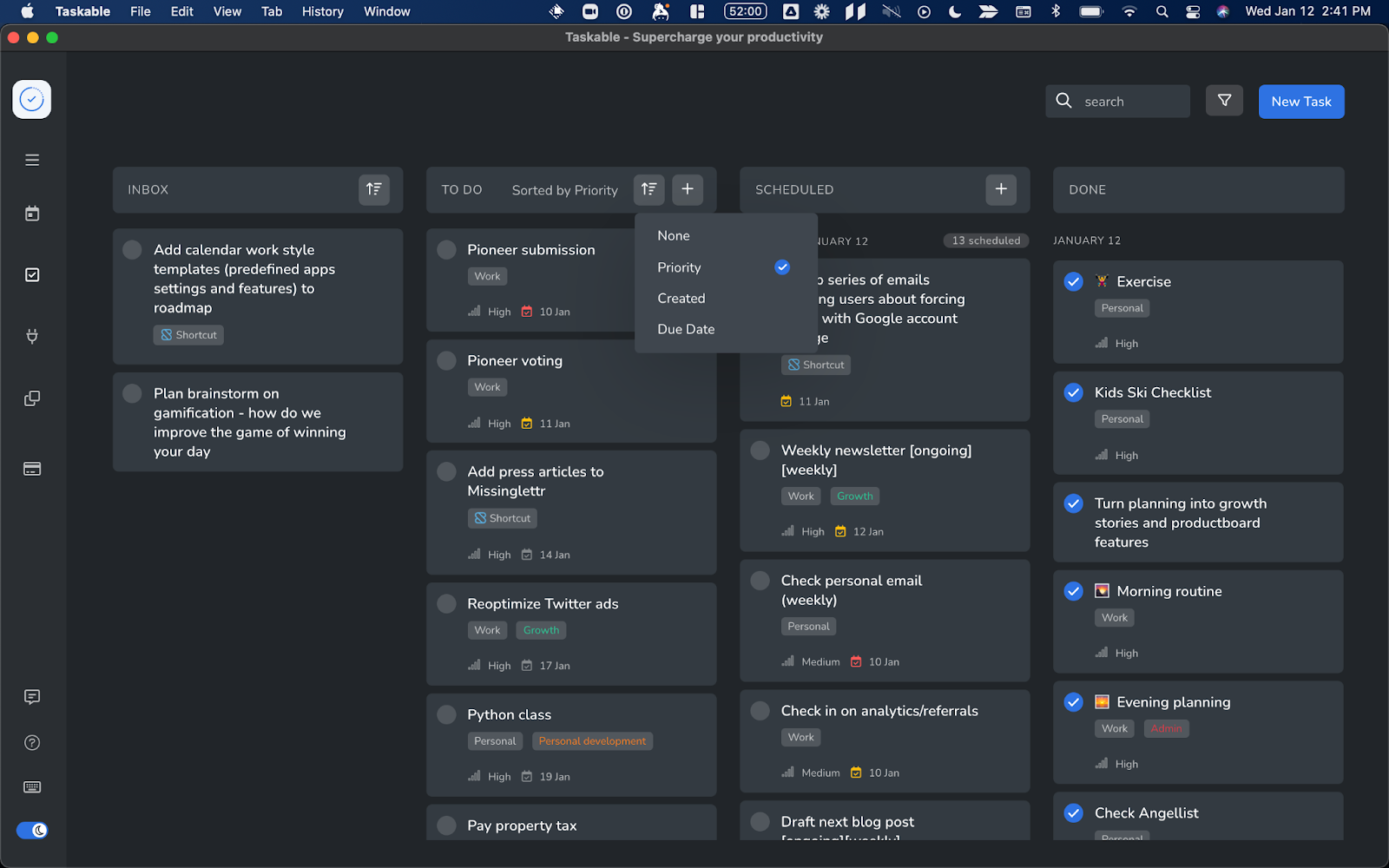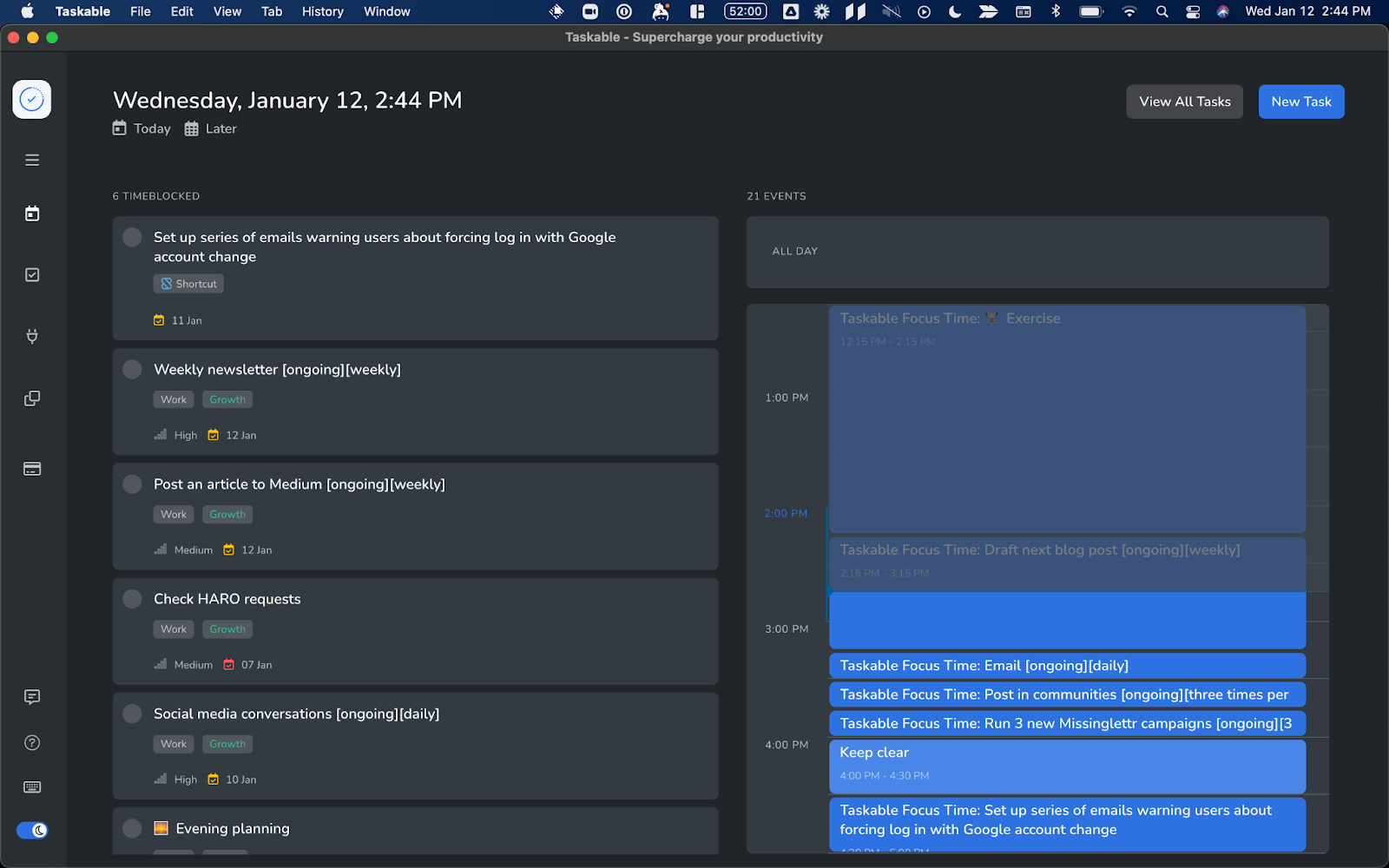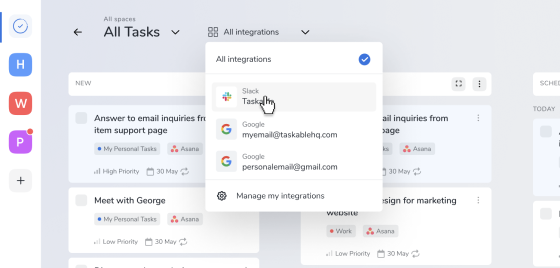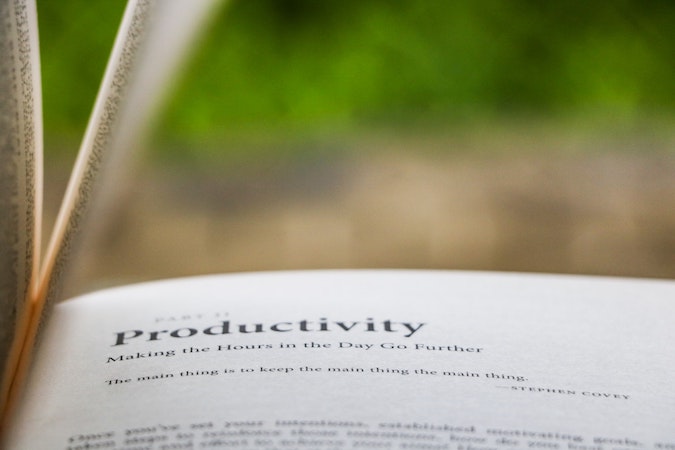My new productivity system for 2021

New year, new productivity system for me! How timeblocking has boosted my productivity and helped me get more done.
As the founder of a productivity tool, I spend a lot of time thinking about productivity and how to improve it. Taskable is a manifestation of the productivity routines my co-founder and I have studied and practiced over the years. More recently, however, our users began requesting features for timeblocking, which had never been part of our productivity routine.
In response, we built a timeblocking feature for Taskable, and this new feature has changed my entire productivity system.
What is timeblocking?
Timeblocking is the practice of breaking your day down into chunks of time, each dedicated to a specific task or initiative.
Before Taskable, timeblocking generally involved looking at your task or project management tool first and then manually entering tasks into your calendar. Now, since the launch of our timeblock feature, you can do this with just a click or two, directly from Taskable, which integrates with the task and project management tools you already use.
Learn more about our timeblocking feature
Since launching our timeblocking feature, I’ve tried timeblocking for the first time. It’s helped me get more things done in a shorter amount of time, all while feeling less stressed and having more time to spend with my family and hobbies.
Here’s how my productivity system has changed and why it works for me.
My new and improved productivity system routines
I have four main rituals in my new productivity system: weekly, morning, and evening planning, along with regular calibration throughout the day.
Weekly planning on Monday
Our team works on weekly sprints. Every Monday, we do sprint planning and decide on initiatives for the week in our project management tool, Shortcut. Everything assigned to me for the sprint syncs to Taskable. Immediately following the weekly sprint meeting, I head over to Taskable. All my new tasks are in my Taskable inbox, where I assign each a priority level. I then move them to my To Do list with the rest of my backlog.

I then sort my To Do list by priority, sorting all my tasks by importance and due date, allowing me to see the biggest impact, most pressing items first. This makes planning my week quick because the obvious things I need to work on first are right there at the top of my list. I then go down my To Do column, and drag tasks into the day of the week I want to work on them. As I go, I try and keep track of whether I will have the time to complete all the tasks I am assigning on a given day and recalibrate.
This weekly planning takes as little as 10 minutes, but it sets me up for success throughout the week and reduces the stress I often feel after sprint meetings because I’ve made a plan for how I can achieve all my tasks.
I then go to my Today view for Monday and timeblock all my tasks for the remainder of the day by dragging and dropping them into my calendar in Taskable.
Regular calibration
Throughout my day, I’ve found I can be pretty accurate with how I’ve allocated my time partly because the inherent challenge of setting aside that timeblock helps me get things done in the time allotted.
However, sometimes that isn’t always the case, and some items take longer or shorter than I expected. I will adjust the timeblock accordingly and move other things around, reschedule them for another day, or add new tasks to today if time allows.

Evening planning
My last timeblock of each day is for my evening planning routine, which takes about 5 minutes. In this session, I reschedule any tasks that weren’t completed today and go into my day tomorrow to see the planned tasks and meetings. I then timeblock out the day and snooze tasks I don’t think I will be able to get to.
What’s great about this is I wake up the following day with a plan already in place, and I reduce the number of surprises I have, such as forgotten meetings or big projects. This helps me mentally prepare for the day ahead.
Morning planning
My final ritual is my morning planning routine, which takes about 5 minutes. I find any last-minute items in my Taskable inbox. I triage these and aim to avoid working on them today unless they are pressing. This allows me to focus more on my priorities, be less reactive to my inbox, and be flexible enough to add new things to my day if they are emergencies or super high priorities.
Why my new productivity system works
I love that my new system incorporates timeblocking because it helps me get more done in a shorter amount of time, with less stress. This is because I have more accountability to myself, I’m more realistic about what I can get done, and thus what my actual priorities are, and it helps me avoid Parkinson’s law, which states work fills the amount of time allotted for its completion.
Whereas before, I had a nebulous list of things to get done, now I have specific time blocks where I am racing against myself to complete an item. Ahead of time, I try to determine what a reasonable amount I would need to complete them is, and I avoid spending hours on something that should take me 30 minutes.
I also feel less guilty about carving out extra time for myself for things like exercise, lunch, or hanging out with my family because I know I am maximizing my time elsewhere. I’ve also started building new habits through timeblocking by allotting time for things like reading or learning new skills.
Summary
Timeblocking has completely changed my productivity system. I start each week planning out what I want to get done each day. Then, each evening I timeblock the next day, and throughout the week, recalibrate my days and my priorities.
This new system helps me get more done in a shorter time by holding me accountable to my time commitments and avoiding Parkinson’s Law.

Subscribe to stay in touch
Resources on startups, productivity, and the future of work delivered right to your inbox.

Your submission has been received!











